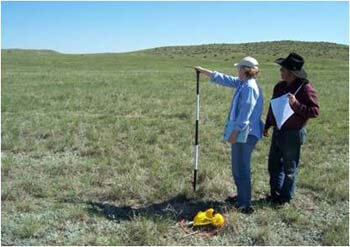Inventory
What to Inventory
Range/Ecological Site
Range Condition
Forage
Rangeland ecosystems are composed of an array of landscape features. The distribution, orientation, and area of landscape features determine how management and use of natural resources can best be accomplished.
Most ranches encompass uplands, lowlands, and drainages. Dunes, ridges, cliffs, canyons, and badlands or rock outcrops increase landscape and habitat diversity. Basins, lowlands, and drainages may contain wetlands with surface water or relatively high water tables. These highly productive sites are often of great value for livestock production and wildlife habitat.
Monitor
What to Monitor
Forage - Carrying Capacity
Range Condition
Many managers do a good job of monitoring livestock and wildlife. However, few actually monitor the most important resource, the vegetation that supports the ranch enterprises. Rangeland vegetation cannot sustain healthy ecosystems when the biological requirements of plants are overlooked. Plants are the primary producers, converting solar energy into usable chemical energy during photosynthesis.
Tracking animal performance is definitely worthwhile, but these records may not tell much about rangeland health. A time lag of several years can exist between deterioration of the ecological and hydrological condition of rangeland before measurable declines in animal performance occur. This is because animals can initially compensate by feeding on less preferred plant species and above average precipitation can mask declines in hydrological condition of land surfaces. By the time animal performance declines, pastures may have degraded to the point where full recovery will take years.
It is said that rangeland plant communities have a memory. Multiple years of precipitation and grazing records are very helpful for cause-and-effect evaluations and for selecting pasture-use-sequences in rotation grazing plans.
Maintaining precipitation and grazing records for every pasture are the most critical rangeland monitoring activities every year. Scouting for indicator species and assessing hydrologic condition of rangeland should also be done annually.
Choosing a Method
Methods
Clip and Weigh
Photopoints
- Q1. How do you plan to use the information?
- Q2. How representative is the information for the entire pasture or management unit?
- Q3. How much time and what skills are needed to conduct the monitoring?
- Q4. How repeatable is the technique? Would the results be similar among several different individuals monitoring the same resources concurrently?
Identifying a Trend
 Rancher working with NRCS to monitor rangeland. Image: Lynn Myers
Rancher working with NRCS to monitor rangeland. Image: Lynn Myers
Rangeland monitoring requires random, repeated observations or measurements of fixed locations for 2 or more years.
Some monitoring methods help ranchers develop a series of mental images for evaluating rangeland health and carrying capacity. These memory banks of images are of great value for field scouting that should occur while checking livestock, fences, or water.
Repeatedly evaluating rangeland with permanent transects, quadrats, or photo points may be appropriate in several scenarios:
- You have substantially changed management practices in one or more pastures, you want to document the response, and you have the necessary time and skill for the appropriate monitoring method.
- You lease grazing from a government or conservation land owner who requires monitoring.
- You signed a cost-share conservation contract that requires monitoring.
- The risk of litigation over management practices on a private-land lease is relatively high.
It is also prudent to have a sunset clause in privately designed monitoring plans. These can be based on the accomplishment of management or educational objectives. As you incorporate what you have learned from fixed-locations into rangeland reconnaissance you may want to reduce the frequency of monitoring. The effects of prolonged drought may warrant a subsequent series of monitoring on sites for which you already have good baseline data.